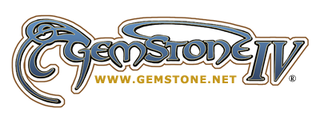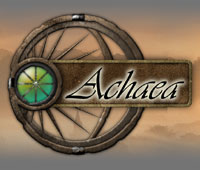A multi-user dungeon, also known as a multi-user dimension or multi-user domain, is a multiplayer real-time virtual world, usually text-based or storyboarded. MUDs combine elements of role-playing games, hack and slash, player versus player, interactive fiction, and online chat. Players can read or view descriptions of rooms, objects, other players, and non-player characters, and perform actions in the virtual world that are typically also described. Players typically interact with each other and the world by typing commands that resemble a natural language, as well as using a character typically called an avatar.
A massively multiplayer online role-playing game (MMORPG) is a video game that combines aspects of a role-playing video game and a massively multiplayer online game.
AberMUD was the first popular open source MUD. It was named after the town Aberystwyth, where it was written. The first version was written in B by Alan Cox, Richard Acott, Jim Finnis, and Leon Thrane based at University of Wales, Aberystwyth for an old Honeywell mainframe and opened in 1987.

Neverwinter Nights is a third-person role-playing video game developed by BioWare. Interplay Entertainment was originally set to publish the game, but financial difficulties led to it being taken over by Infogrames, who released the game under their Atari range of titles. It is the first installment in the Neverwinter Nights series and was released for Microsoft Windows on June 18, 2002. BioWare later released a Linux client in June 2003, requiring a purchased copy of the game to play. MacSoft released a Mac OS X port in August 2003.
DikuMUD is a multiplayer text-based role-playing game, which is a type of multi-user domain (MUD). It was written in 1990 and 1991 by Sebastian Hammer, Tom Madsen, Katja Nyboe, Michael Seifert, and Hans Henrik Stærfeldt at DIKU —the department of computer science at the University of Copenhagen in Copenhagen, Denmark.

Ancient Anguish, abbreviated AA, is a fantasy-themed MUD, a text-based online role-playing game. Founded in 1991 by Balz "Zor" Meierhans and Olivier "Drake" Maquelin, it opened to the public on February 2, 1992. It is free-to-play, but has been supported by player donations since 1994.

GemStone IV is a multiplayer text-based online role-playing video game produced by Simutronics. Players control characters in a high fantasy game world named "Elanthia". The first playable version of the game was known as GemStone ][ and was launched in April 1988 on GEnie. It was one of the first MMORPGs and is one of the longest running online games still active. Access to the game is subscription-based through its website, with three additional subscriptions levels available, "Premium", "Platinum" and "Shattered", in addition to a free-to-play model introduced in early March 2015.
A massively multiplayer online game is an online video game with a large number of players on the same server. MMOs usually feature a huge, persistent open world, although there are games that differ. These games can be found for most network-capable platforms, including the personal computer, video game console, or smartphones and other mobile devices.
Player versus player (PvP) is a type of multiplayer interactive conflict within a game between human players. This is often compared to player versus environment (PvE), in which the game itself controls its players' opponents. The terms are most often used in games where both activities exist, particularly MMORPGs, MUDs, and other role-playing video games, to distinguish between gamemodes. PvP can be broadly used to describe any game, or aspect of a game, where players compete against each other. PvP is often controversial when used in role-playing games. In most cases, there are vast differences in abilities between players. PvP can even encourage experienced players to immediately attack and kill inexperienced players. PvP is often referred to as player killing in the cases of games which contain, but do not focus on, such interaction.

Richard Allan Bartle FBCS FRSA is a British writer, professor and game researcher in the massively multiplayer online game industry. He co-created MUD1 in 1978, and is the author of the 2003 book Designing Virtual Worlds.

The Realm Online, originally known as The Realm, is a massively multiplayer online role playing game (MMORPG) launched in December 1996 for Windows PC. It was designed in the tradition of graphical MUDs, before the usage of the terms "massively multiplayer" and "MMORPG".
Player versus environment is a term used for both single player and online games, particularly MMORPGs, CORPGs, MUDs, other online role-playing video games and survival games to refer to fighting computer-controlled enemies - in contrast to PvP. In survival games a large part may be fighting the elements, controlling hunger and thirst, learning to adapt to the environment and exploration.
A mob, short for mobile or mobile object, is a computer-controlled non-player character (NPC) in a video game such as an MMORPG or MUD. Depending on context, every and any such character in a game may be considered to be a "mob", or usage of the term may be limited to hostile NPCs and/or NPCs vulnerable to attack.
Dragon's Gate was an interactive, real time, text-based multi user online fantasy role-playing game, sometimes referred to as a MUD. It was one of the longest running pay-for-play online games in the world, it opened to the public in the spring of 1990 on GEnie. In 1996 the game was moved to AOL. Later the game was moved to Mythic Realms, and finally to independent server, where it ran until the summer of 2007.
A mini-map or minimap is a miniature map HUD element that is often placed at a screen corner in video games to help players in orienting themselves within the game world. They are often only a small portion of the screen and must be selective in what details they display. Elements included on mini-maps vary by video game genre. However, most minimaps feature at least one or more of the following: the position of the player character, allied units, structures, enemies, objectives, and surrounding terrain.

Achaea, Dreams of Divine Lands is a roleplay-focused, text-based multi-user dungeon (MUD) released on September 9, 1997. It was published by Achaea LLC, now known as Iron Realms Entertainment. Achaea is operated by collecting the revenue through a microtransaction system, which allows payment for the acquisition of in-game benefits.

The Bartle taxonomy of player types is a classification of video game players (gamers) based on a 1996 paper by Richard Bartle according to their preferred actions within the game. The classification originally described players of multiplayer online games, though now it also refers to players of single-player video games.
The history of massively multiplayer online games spans over thirty years and hundreds of massively multiplayer online games (MMOG) titles. The origin and influence on MMO games stems from MUDs, Dungeons & Dragons (D&D) and earlier social games.
TinyMUCK or, more broadly, a MUCK, is a type of user-extendable online text-based role-playing game, designed for role playing and social interaction. Backronyms like "Multi-User Chat/Created/Computer/Character/Carnal Kingdom" and "Multi-User Construction Kit" are sometimes cited, but are not the actual origin of the term; "muck" is simply a play on the term MUD.

Avalon: The Legend Lives is a text-based online multi-player role-playing game world that was first released on 28 October 1989 at the gaming convention Adventure 89. It has maintained a near-continuous on-line presence with consistent and intact persona files and player history since the late 1980s. Until regular outages began occurring in 2023, it was the longest continuously running online role-playing game in history.







